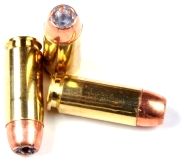 I didn’t know Jeff Cooper, and I’m not sure he would have liked me had we met. He was a serious gunner and combat expert, a genuine tough guy. Whereas, when I get an “owie” when working in my shop, my wife still applies a Mickey Mouse Band-Aid to make it all better. Some of Cooper’s work was breakthrough, some of it retread. Some of it serious business, some of it puffery. A product of his creativity that outlived him, one I sincerely appreciate, is the 10mm Auto cartridge. The 10mm Auto is a round that offers more utility than a 1911 stuffed full of .45 ACP +P ammo. Where the 40 S&W is sort of like Jimmie Vaughan and the Fabulous Thunderbirds, the 10mm Auto is more like Stevie Ray and the best of “Double Trouble”.
I didn’t know Jeff Cooper, and I’m not sure he would have liked me had we met. He was a serious gunner and combat expert, a genuine tough guy. Whereas, when I get an “owie” when working in my shop, my wife still applies a Mickey Mouse Band-Aid to make it all better. Some of Cooper’s work was breakthrough, some of it retread. Some of it serious business, some of it puffery. A product of his creativity that outlived him, one I sincerely appreciate, is the 10mm Auto cartridge. The 10mm Auto is a round that offers more utility than a 1911 stuffed full of .45 ACP +P ammo. Where the 40 S&W is sort of like Jimmie Vaughan and the Fabulous Thunderbirds, the 10mm Auto is more like Stevie Ray and the best of “Double Trouble”.
Case in point…
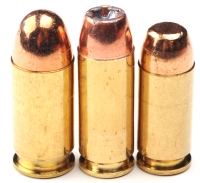 The 10mm Auto (center) has a case length of 0.992″ and a maximum overall cartridge length of 1.260″. That makes its case length 0.142″ longer than that of the .40 S&W (right) and its overall cartridge length 0.125″ greater. At 24.0 grains, the 10mm’s case capacity is approximately 4 grains more than the 40 S&W.
The 10mm Auto (center) has a case length of 0.992″ and a maximum overall cartridge length of 1.260″. That makes its case length 0.142″ longer than that of the .40 S&W (right) and its overall cartridge length 0.125″ greater. At 24.0 grains, the 10mm’s case capacity is approximately 4 grains more than the 40 S&W.
In comparison to the .45 ACP (left), the 10mm auto case is 0.094″ greater in length, however, the 10mm is 0.015″ shorter in overall cartridge length and the larger diameter .45 ACP case holds approximately 4 more grains of powder.
The 10mm gets its performance edge over the 40 S&W as a result of greater powder capacity, while its length, case and overall cartridge means the 10mm will function is a 1911 form firearm. The 10mm Auto is a rimless case that headspaces on its mouth with bullets secured with a taper crimp. The case takes a large pistol primer. Pictured is Starline brand brass, the type selected for my own handloads. The alloy is probably the same as other major brands, however, the heat treat tends to be different. Their brass seems more malleable and it seems to last longer.
Bullet points…
The 10mm Auto’s bullet is 0.400″ diameter for jacketed versions and 0.401″ for cast, which means there are more types and weights available than most people will ever need. On a casual look, I found 65 brand, type and weight variations. There are full metal jackets for target work, frangible types for special circumstance self defense and jacketed soft and hollow points for self defense and hunting. Bullet weights range runs from 135 grains to 200 grains, with 180 grains arguably the most popular weight. Five bullet types were selected for this project that are a good representation of what might be selected as useful for the 10mm Auto shooter/handloader. They appear on the table in the L-R order they appear in the picture below the table.
|
Bullet |
Type | Grains | Diameter “ | Length “ |
| Remington | JHP | 155 | 0.4000 | 0.550 |
| Speer Gold Dot | JHP | 155 | 0.4000 | 0.542 |
| Remington Golden Saber | JHP- DB | 165 | 0.4000 | 0.573 |
| Remington Golden Saber | JHP-DB | 180 | 0.4000 | 0.638 |
| Hornady HP/XP | JHP | 200 | 0.3995 | 0.682 |
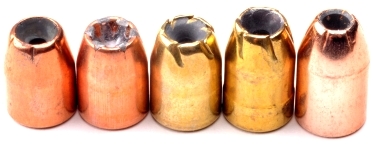
The Golden Saber bullets have a driving band, meaning the tail end of the shank is barrel groove diameter, in this case 0.400″, and the parallel surfaces of the shank forward of the driving band, but aft of the bullet’s ogive, are slightly smaller in diameter. In the case of the 165 grain GS, the bullet diameter only diminishes by 0.002″ forward of the 0.260″ wide driving band. The 180 grain GS driving band is only 0.200″ wide and the shank decreases in diameter by a full 0.010″. The Hornady is listed as 0.400″ in diameter, however, they had an actual diameter of 0.3995″, which is of no consequence. What was of consequence was cutting open a bulk pack bag of Remington bullets I purchased from a large online discount retailer, scale checking them as I tend to do, and finding that they were labeled as 180 grains when, in fact, they were 155 grain bullets. Handloading is a good place to check everything twice.
I have not noticed a real difference in expansion characteristics when these bullets are loaded in the 10mm Auto or the .40 S&W. The tough slow to expand bullets remain the same and the Gold Saber and Gold Dots still hold up in either application. I particularly like Golden Saber for self defense loads because they expand fully, hold together over a wide velocity range and they tend not to over penetrate. The others are basically tough expanding jacketed bullets for increased penetration where situations require; handgun hunting, trail defense or bringing a Chevy small block to a halt should the occasion arise. All of the bullets listed can be assembled into accurate handloads. The Golden Saber bullets tend to produce higher velocity for any given weight class as a result of the bullets low bearing surface and driving band geometry.
Powder? Not so fast…
Whenever possible, I try to use powder that falls on the slow side of what is applicable for a cartridge. If weight errors and variations are constant in terms of weight, a tenth of a grain rather than a percentage of a charge, the larger the charge, proportionally the smaller the errors, the smaller the error the more consistent the ammo’s performance. There is a much greater material performance difference from a 0.2 grain charge variance with Bullseye than there is with AA 9. I did assemble some light Power Pistol based loads for recreational target practice with inexpensive bullets. All loads were assembled with CCI large Pistol Magnum primers.
Dies…one size fits all
 Other than Redding, die manufacturers tend to combine 40 S&W and 10mm Auto capability into single die sets. This makes sense as the cartridges share enough common dimensions that only modest set up adjustments are required to switch from one cartridge to the other. Typically, the set up adjustment is made to bullet seating die.
Other than Redding, die manufacturers tend to combine 40 S&W and 10mm Auto capability into single die sets. This makes sense as the cartridges share enough common dimensions that only modest set up adjustments are required to switch from one cartridge to the other. Typically, the set up adjustment is made to bullet seating die.
I used a basic set of RCBS carbide dies with an integral taper crimp function. An enclosed slip sheet advises to begin with the seater die a minimum of 3/16″ off of the shell holder.
Handloads that performed well…good..er
I can only say what every handloader should already know; check posted handload data against established mainstream data to see if there are realistic similarities. Back off 10% as a starting point, work up as an absence of excessive pressure symptoms allow. Don’t write to Joe and ask him why his data doesn’t match QuickLOAD, especially since QuickLOAD is not intended for straight wall pistol cartridge use and because there is something wrong with QuickLOAD’s representation of AA #9.
| 10mm Auto | Chrono | ||||
| Bullet | Weight | COL | Powder | Charge | Velocity |
| Remington JHP | 155 | 1.260 | AA 7 | 12.5 | 1392 |
| Blue Dot | 11.5 | 1443 | |||
| HS 6 | 10.5 | 1398 | |||
| Speer Gold Dot | 155 | 1.250″ | AA 7 | 12.5 | 1349 |
| Blue Dot | 11.5 | 1377 | |||
| HS 6 | 10.0 | 1177 | |||
| Remington Golden Saber | 165 | 1.260 | Power Pistol | 10.0 | 1340 |
| AA 9 | 15.0 | 1265 | |||
| AA 7 | 12.0 | 1324 | |||
| Remington Golden Saber | 180 | 1.260 | Long Shot | 9.5 | 1241 |
| AA 9 | 14.5 | 1276 | |||
| Blue Dot | 10.5 | 1322 | |||
| Hornady HP-XTP | 200 | 1.250 | Long Shot | 8.0 | 1166 |
| AA 9 | 13.0 | 1161 | |||
| Blue Dot | 9.0 | 1220 | |||
| Remington JHP | 155 | 1.260 | Pwr Pistol | 8.0 | 1169 |
Easy to shoot, even when it is cold outside…
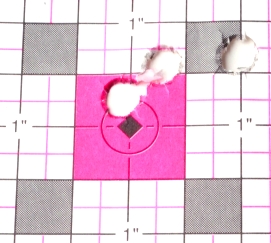 I believe this is about typical for 7 yard shooting. An inch even, or slightly less, was the norm for a two hand hold with shots fired between shivers. It was 2°F here so I took advantage of that heat wave to get the shooting portion of the project completed.
I believe this is about typical for 7 yard shooting. An inch even, or slightly less, was the norm for a two hand hold with shots fired between shivers. It was 2°F here so I took advantage of that heat wave to get the shooting portion of the project completed.
A typical 25 yard group, two hand hold, but cheating by resting against a porch column, was two and one quarter inches. Excellent accuracy for a trail gun and, in the hands of a more competent shooter, good accuracy for a hunting handgun. I am sure the gun could be slicked up a little bit for accuracy and different sights could be easily installed for more precise control over windage, elevation and point of impact adjustment.
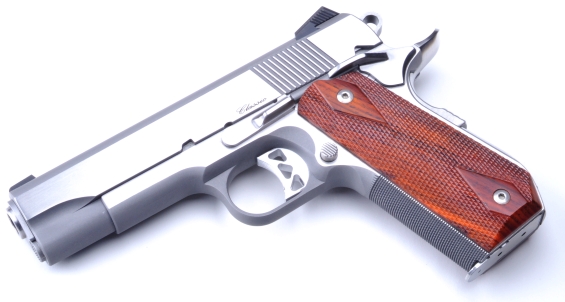
For a compact 1911 and a pretty hot round, the Dan Wesson is easy to shoot and recoil is moderate, regardless the load. The only problem I encountered was a slide stop that would occasionally lock the slide open with a partially full magazine. I believe I was able to trace the problem to perhaps a slightly long slide stop tab that was getting picked up by some of the longer ogive bullets. My guess is that the corrective action is five minutes with a file and an Arkansas stone, but I will leave that to someone with more expertise. Some of the heavier loads produced some flatter, rather than flat primers, but nothing exceptional and certainly not a condition caused by the gun. Nothing shot loose, fell off or in anyway demonstrated signs of excessive wear and tear during the entire project.
For all of the live fire and handling, this gun just wasn’t going to look any the less for wear and tear. A little wipe off between session took off all of the carbon and powder deposits. Nothing galled on contact surfaces and there wasn’t so much as a ding or rub mark on the finish. The Commander size had a distinct advantage in handling and shooting, while the 10mm Auto round seemed to do well with the 4.3″ barrel. Handloading the round was pretty straightforward.
The folks at CZ have put together a great little 1911; fancy well beyond its price tag, excellent parts fit and accuracy. A real value in a premium 1911, reliable operation and lots of power.
Dan Wesson’s Commander Classic Bobtail Part I
Dan Wesson’s Commander Classic Bobtail Part II

Email Notification